Emergency medical services in the United Kingdom
Emergency medical services in the United Kingdom provide emergency care to people with acute illness or injury and are predominantly provided free at the point of use by the four National Health Services of England, Scotland, Wales, and Northern Ireland. Emergency care including ambulance and emergency department treatment is free to everyone, regardless of immigration or visitor status.[1]
.jpg)
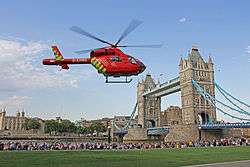
The NHS commissions most emergency medical services through the 14 NHS organisations with ambulance responsibility across the UK (11 in England, 1 each in the other three countries).
As with other emergency services, the public normally access emergency medical services through one of the valid emergency telephone numbers (either 999 or 112).[2]
In addition to ambulance services provided by NHS organisations, there are also some private and volunteer emergency medical services arrangements in place in the UK, the use of private or volunteer ambulances at public events or large private sites, and as part of community provision of services such as community first responders.
Most air ambulance services in the UK are not part of the NHS and are funded through charitable donations. Paramedics are usually seconded from a local NHS ambulance service.
Role of the ambulance services
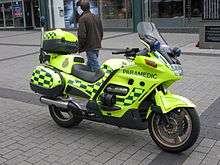
Public ambulance services across the UK are required by law to respond to four types of requests for care,[3] which are:
- Emergency calls (via the 999 or 112 system)
- Doctor's urgent admission requests
- High dependency and urgent inter-hospital transfers
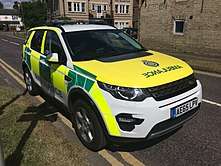 An East of England Ambulance Service Rapid Response Vehicle (RRV)
An East of England Ambulance Service Rapid Response Vehicle (RRV) - Major incidents
Ambulance trusts and services may also undertake non-urgent patient transport services on a commercial arrangement with their local hospital trusts or health boards, or in some cases on directly funded government contracts,[4] although these contracts are increasingly fulfilled by private and voluntary providers.
History
The National Health Service Act 1946 gave county and borough councils a statutory responsibility to provide an emergency ambulance service, although they could contract a voluntary ambulance service to provide this, with many contracting the British Red Cross, St John Ambulance or another local provider. The last St John Division, (the original designation of a local unit, now called 'branches'), to be so contracted is reputed to have been at Whittlesey in Cambridgeshire, where the two-bay ambulance garage can still be seen at the branch headquarters. The Regional Ambulance Officers’ Committee reported in 1979 that “There was considerable local variation in the quality of the service provided, particularly in relation to vehicles, staff and equipment. Most Services were administered by Local Authorities through their Medical Officer of Health and his Ambulance Officer, a few were under the aegis of the Fire Service, whilst others relied upon agency methods for the provision of part or all of their services.”
The 142 existing ambulance services were transferred by the National Health Service Reorganisation Act 1973 from local authority to central government control in 1974, and consolidated into 53 services under regional or area health authorities.[5]
This led to the formation of predominantly county based ambulance services, which gradually merged up and changed responsibilities until 2006, when there were 31 NHS ambulance trusts in England.
The June 2005 report "Taking healthcare to the Patient", authored by Peter Bradley,[6] Chief Executive of the London Ambulance Service, for the Department of Health led to the merging of the 31 trusts into 13 organisations in England,[7] plus one organisation each in Wales, Scotland, and Northern Ireland. Following further changes as part of the NHS foundation trust pathway, this has further reduced to 10 ambulance service trusts in England, plus the Isle of Wight which has its own provision.
Following the passage of the Health and Social Care Act 2012, commissioning of the ambulance services in each area passed from central government control into the hands of regional clinical commissioning groups.
Current public provision
The commissioners in each region are responsible for contracting with a suitable organisation to provide ambulance services within their geographical territory. The primary provider for each area is currently held by a public NHS body, of which there are 11 in England, and 1 each in the other three countries.
England
In England there are now ten NHS ambulance trusts, as well as an ambulance service on the Isle of Wight, run directly by Isle of Wight NHS Trust, with boundaries generally following those of the former regional government offices. The ten trusts are:
- East Midlands Ambulance Service NHS Trust
- East of England Ambulance Service NHS Trust
- London Ambulance Service NHS Trust
- North East Ambulance Service NHS Foundation Trust
- North West Ambulance Service NHS Trust
- South Central Ambulance Service NHS Foundation Trust
- South East Coast Ambulance Service NHS Foundation Trust
- South Western Ambulance Service NHS Foundation Trust
- West Midlands Ambulance Service University NHS Foundation Trust
- Yorkshire Ambulance Service NHS Trust
The English ambulance trusts are represented by the Association of Ambulance Chief Executives (AACE), with the Scottish, Welsh and Northern Irish providers all associate members. On the 14 November 2018 West Midlands Ambulance Service became the UK's first university-ambulance trust.[8]
Scotland
The service was operated before reorganisation in 1974 by the St Andrews’ Ambulance Association under contract to the Secretary of State for Scotland.[5] The Scottish Ambulance Service is a Special Health Board that provides ambulance services throughout whole of Scotland, on behalf of the Health and Social Care Directorates of the Scottish Government.[9]
Due to the remote nature of many areas of Scotland compared to the other Home Nations, the Scottish Ambulance Service has Britain's only publicly funded air ambulance service, with two Airbus Helicopters H145 Helicopters and two Beechcraft B200C King Air fixed-wing aircraft. There is also a partnership to provide the Emergency Medical Retrieval Service which gives rapid access to the skills of a consultant in emergency or intensive care medicine using Scottish Ambulance Service road and air assets.[10]
Northern Ireland
The Northern Ireland Ambulance Service (NIAS) was established in 1995 by order in council,[11] and serves the whole of Northern Ireland. To date universities in Northern Ireland do not facilitate Paramedic Science (BSc) degree meaning members must complete their degree either in England, Wales or Scotland.
Wales
The Welsh Ambulance Service NHS Trust (Welsh: Ymddiriedolaeth GIG Gwasanaethau Ambiwlans Cymru) was established on 1 April 1998, and has 2,500 staff providing ambulance and related services to the 2.9 million residents of Wales.[12]
Usage
The ambulance services across England have been increasingly busy, with a significant increase in calls in the last two decades,[7] as shown in the table below:
| Year | Emergency calls | Source |
|---|---|---|
| 1994/5 | 2.61 million | [7] |
| 2004/5 | 5.62 million | [7] |
| 2006/7 | 6.3 million | [13] |
| 2012/3 | 9.08 million | [14] |
Calls where a Category A ambulance arrived at the scene rose from 6,856 per day in 2011–12 to 8,564 per day in 2014–15.[15]
Private, voluntary and charity ambulance services
There is a large market for private and voluntary ambulance services, with the sector being worth £800m to the UK economy in 2012.[16] Since April 2011, all ambulance providers operating in England have been required by law to be registered with the Care Quality Commission, under the same inspection regime as NHS services, and there are currently around 250 credentialled providers.[17]
The primary activities of the private and voluntary services include:
- the provision of ambulances as part of a wider service of first aid at events, construction sites, film sets, or other private provision
- the provision of additional resource to NHS ambulance trusts
- urgent patient transport between points of care (such as between two hospitals)
- non-urgent patient transport
All providers, including NHS, private, and voluntary can bid for many of the available contracts for provision of ambulance services, and private ambulance services now undertake over half of hospital transfers.[18] This places the voluntary providers in direct competition with private services, although the private sector has been growing at the expense of the voluntary services over time.
There is a duty on Category 1 responders (including the NHS) to make appropriate arrangements for major incidents, and as such private and voluntary ambulance services are generally included as part of local planning for the provision of ambulance services during major incidents, such as mass casualty events (including 7 July 2005 London bombings), adverse weather, or severe staff shortage.
Private ambulance services
Private ambulance services are common in the UK, with over 200 providers, and their use under contract to the NHS to answer 999 calls has been growing year on year,[19] with every NHS ambulance trust using private providers in each year from 2011–2014, and contracted providers answering three quarters of a million 999 calls in that three-year period.[20] Expenditure on private ambulances in England increased from £37m in 2011–12 to £67.5m in 2013/4, rising in London from £796,000 to more than £8.8m.[21] In 2014–15, these 10 ambulance services spent £57.6 million on 333,329 callouts of private or voluntary services – an increase of 156% since 2010–11.[15] This use of private contractors for frontline services has been politically controversial,[22][23] although 56% of the British public believe that greater private sector involvement will help maintain or improve standards in the NHS.[24]
In 2013, the Care Quality Commission found 97% of private ambulance services to be providing good care.[17] These private, registered services are represented by the Independent Ambulance Association. In 2017 the Commission warned all independent ambulance providers that during its inspections it had found “problems with the safety” of the care offered. 70 independent ambulance providers had been inspected and improvement notices had been issued to 25 out of 39 whose reports had been published. Plymouth Central Ambulance Service and Intrim Medical and Rescue Services were closed down after very poor practice was found.[25]
There are also a number of unregistered services operating, who do not provide ambulance transport, but only provide response on an event site. These firms are not regulated, and are not subject to the same checks as the registered providers, although they may operate similar vehicles, and offer near identical services.[18]
Voluntary aid services
There are a number of voluntary ambulance providers, sometimes known as Voluntary Aid Services or Voluntary Aid Societies (VAS), with the main ones being the British Red Cross and St John Ambulance. The history of the voluntary ambulance services pre-dates any government organised service, and includes service in both World Wars.
As they are in direct competition for work with the private ambulance providers, the voluntary providers do operate with some paid ambulance staff to fulfil their contracts.
Voluntary organisations have also provided cover for the public when unionised NHS ambulance trust staff have taken industrial action.[26]
There are a number of smaller voluntary ambulance organisations, fulfilling specific purposes, such as Hatzola who provide emergency medical services to the orthodox Jewish community in some cities.[27] [28][29][30][31] These have however run into difficulties due to use of vehicles not legally recognised as ambulances.[32]
The British Association for Immediate Care (BASICS) has numerous medical staff (including doctors, nurses and paramedics) who volunteer their time to respond to serious medical emergencies. (see below: Supporting services)
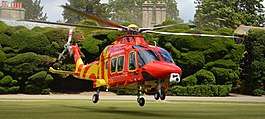
Charity air ambulances
Most UK emergency air ambulances are funded by charitable organisations, with medical staff usually seconded from the local NHS trust. The only exceptions are in Scotland & Wales. The Scottish Ambulance Service provides funding for two helicopters and two fixed wing aircraft. The Welsh Assembly Government fully funds the clinical and road components of the Emergency Medical Retrieval and Transfer (EMRTS) Cymru service, with aviation (HEMS capability) provided in partnership with the Wales Air Ambulance Charity. There is an additional helicopter, Scotland's Charity Air Ambulance, which is funded by charitable donations only.
Regulation, governance and monitoring
All emergency medical services in the UK are subject to a range of legal and regulatory requirements, and in many cases are also monitored for performance. This framework is largely statutory in nature, being mandated by government through a range of primary and secondary legislation.
Regulation
In England all ambulance services, as well as some medical response organisations like BASICS, are regulated by the Care Quality Commission (CQC) under the provisions of the Health and Social Care Act 2008 and subsequent Health and Social Care Act 2008 (Regulated Activities) Regulations 2010.
This requires all providers to register, to meet certain standards of quality, and to submit to inspection of those standards.[33] Organisations not meeting the standards can be sanctioned, or have their registration removed, preventing them from offering any medical services.
The CQC replaced the previous regulator of England's NHS ambulance services, the Healthcare Commission, with its remit expanded to include all private and voluntary providers. Independent ambulance services have only been subject to formal regulation since 2011.[33]
In addition to regulation by the Care Quality Commission on matters of service provision, providers of NHS services are also subject to regulation by either Monitor (for NHS foundation trusts or private providers) or the NHS Trust Development Authority (for NHS services who are not yet foundation trusts) for economic and financial matters.
Measuring performance
The performance of every NHS ambulance provider is measured and benchmarked by the government. Commonly called 'ORCON',[34] after the consultancy used to formulate them, the New Ambulance Performance Standards (NAPS) were developed in the 1990s, and merged into the Clinical Quality Indicators used subsequently. New targets were established in July 2017. See NHS ambulance services.
The benchmarked targets include:[2]
- Service experience – patient satisfaction with the service
- Outcome from acute STEMI – the number of patients who recover from a heart attack
- Outcome from cardiac arrest – the number of patients who get a return of spontaneous circulation and those who are discharged from hospital
- Outcome following stroke
- Proportion of calls closed with telephone advice – also known as "hear and treat"
- Proportion of calls managed without transport to A&E – also known as "see and treat"
- Recontact rate following discharge of care – patients who have had 'hear and treat' or 'see and treat' and who subsequently call 999 again
- Call abandonment rate – the number of people who don't get through to an ambulance dispatcher
- Time to answer calls – the time it takes to answer the phone
- Time until treatment by an ambulance – the wait time between calling and a health care professional being dispatched
- Category A response time – in cases triaged as Category A (life-threatening) by the triage software (AMPDS and NHS Pathways are the two approved systems), services are targeted to reach the patient within eight minutes of the call. In England, ambulance services are targeted on reaching 75% of Category A calls in 8 minutes, compared to 65% in Wales.
Governance
Every ambulance provider is responsible to the CQC for compliance with best practice. Best practice guidance is published by the Joint Royal Colleges Ambulance Liaison Committee (JRCALC), and most providers follow the majority of this issued guidance.
Staffing
There are a range of staff grades who work in emergency medical services in the UK. The majority of staff fall into four main categories (in ascending skill order):
- Emergency care assistants – Usually work as part of a crew, alongside a paramedic. They operate in support of a paramedic or technician, performing duties such as driving, and first aid skills. As with technician, there is significant variation in the training levels between providers.
- Technician or Associate Ambulance Practitioner (AAP) – technicians either support paramedics, or work autonomously. There is no single definition or qualification which covers all technicians, and they vary by service, especially between NHS and private providers
- Paramedic – paramedics are the core medical treatment grade, and the title is protected (meaning only those registered with the Health and Care Professions Council are entitled to use it, paramedics have autonomous practice, and a range of skills including intravenous cannuulation and advanced airway. In 2014 pay starts between £21,500 to £28,000 depending on experience and rises to £34,500 for team leaders and extended skills training. A full-time working week is 37.5 hours including night and weekend shifts as well as public holidays. Annual leave starts at 27 days per year plus public holidays or time in lieu and rising to 33 after 10 years’ service.[35]
- Specialist Advanced paramedic – such as an advanced paramedic, critical care paramedic, paramedic practitioner, HEMS paramedic or emergency care practitioner, who may have extra skills such as prescribing medication or administering additional drugs. Many specialist paramedics are trained to aid in delivering roadside procedures that are performed by doctors from, for example, an air ambulance, most ambulance trusts train Specialist or Advanced Paramedics at a MSc standard.[36]
In 2014/5 Ambulance Trusts were forced to look overseas to fill vacancies for paramedics. Only one was recruited from outside the UK in 2013-4 but 183 had been recruited since April 2014. Of these 175 were recruited by the London Ambulance Service from Australia. Across England, ambulance services reported that 1,382 of 15,887 posts were vacant – a rate of 9%.[37]
Other roles within the NHS Ambulance Services include Ambulance Nurse (presently only employed by South Central Ambulance Service and identical in role to Paramedic, allowing interchangeability), Emergency Care Practitioner and similar Specialist Paramedic/Nurse roles with a focus on admission avoidance, and a broad range of support staff.
Supporting services
BASICS
The British Association for Immediate Care coordinates voluntary schemes, and individual medical and allied health professionals, providing immediate care throughout the UK.[38] BASICS doctors, nurses or paramedics may assist NHS paramedics at the scenes of serious accidents or be on-hand at major sporting events. All professionals volunteer their time, but doctors must have undergone additional training to support their working-environment.
Blood Bikes
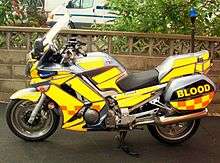
Across the British Isles, a network of volunteer Blood Bikes charity groups provide motorcycle courier services for blood, tissue and organs which require transport to, or between, hospitals. Some are equipped with blue lights and sirens which can be used when transporting urgent blood or human tissue for transplant. Groups are largely independent, and operate in collaboration with their local healthcare providers. Many are represented through the Nationwide Association of Blood Bikes (NABB).[39]
Community first responders
Volunteer community first responders (CFRs) are now common place resources for NHS Ambulance Service. CFRs are members of the public who have received training to answer ambulance 999 calls, and respond immediately within their local area, during their own time. The schemes originated to provide defibrillation in rural and remote areas, where ambulances could not quickly respond, although they are now present in both rural and urban areas.
CFRs are often operated by a local group, in partnership with the regional NHS ambulance trust, and carry a defibrillator and oxygen, along with other equipment as decided by the clinical governance arrangements. Some schemes have their own vehicles and actively fundraise to support their schemes.
Fire Service Responders
In more rural areas where ambulance responses can take longer, fire personnel have been trained in basic first aid and pain management. They are trained in CPR, use of an AED, oxygen and entonox. They normally take a call from the ambulance Emergency Operations Centre and respond in a car fitted with blue lights, sirens and ambulance / fire service livery. This service is normally staffed by retained firefighters.
References
- "Am I entitled to NHS treatment when I visit England?". NHS Choices. Archived from the original on 1 March 2015.
- "NHS ambulance services". NHS Choices. Archived from the original on 30 October 2009. Retrieved 28 September 2015.
- "Ambulance Service Definition". Archived from the original on 28 October 2007. Retrieved 15 June 2007.
- "NHS Ambulance Trusts Description". Archived from the original on 27 May 2007. Retrieved 15 June 2007.
- "Royal Commission on the National Health Service". Socialist Health Association. HMSO. Archived from the original on 21 May 2015. Retrieved 12 June 2015.
- "Taking Healthcare to the Patient". COI Communications for the Department of Health. June 2005. Archived from the original on 31 October 2007. Retrieved 15 June 2007.
- "NHS Information on Ambulance Services". Archived from the original on 11 June 2007. Retrieved 2007-06-14.
- https://wmas.nhs.uk/2018/11/14/new-partnership-blue-lights-the-way-for-university-and-ambulance-service/
- "Scottish Ambulance Service framework document" (PDF). Scottish Ambulance Service. 12 December 2013. Archived (PDF) from the original on 18 October 2014. Retrieved 18 October 2014.
- "What we do". Emergency Medical Retrieval Service. Archived from the original on 23 October 2014. Retrieved 18 October 2014.
- "Northern Ireland Ambulance Service Trust". Archived from the original on 19 May 2007. Retrieved 2007-06-15.
- "About us". Welsh Ambulance Services NHS Trust. Archived from the original on 10 September 2015. Retrieved 28 September 2015.
- "Emergency ambulance calls 'peak'". BBC News. 21 June 2007. Archived from the original on 1 September 2007. Retrieved 22 June 2007.
- "Ambulance Services, England – 2012–13 [NS]". Health and Social Care Information Centre. 19 June 2013. Archived from the original on 16 July 2014. Retrieved 18 October 2014.
- "NHS spending on private ambulances soars to meet demand". Daily Telegraph. 10 August 2015. Archived from the original on 26 August 2015. Retrieved 22 August 2015.
- Plimsoll, 2013, Ambulance Services Market Report
- "Market Report 2012" (PDF). Care Quality Commission. Archived (PDF) from the original on 1 March 2015.
- Independent Ambulance Association (November 2013). "The Vital Link" (PDF). Archived from the original (PDF) on 30 April 2015. Cite journal requires
|journal=(help) - Donnelly, Laura (21 February 2009). "NHS bosses send 'ill-trained' private ambulance crews to 999 calls". The Telegraph. Archived from the original on 11 November 2012.
- "Use of private ambulance support". WhatDoTheyKnow. Archived from the original on 9 July 2015. Retrieved 26 August 2014.
- Morris, Nigel (21 October 2014). "Spending on private ambulances has risen by 82% in two years". The Independent. Archived from the original on 21 July 2015. Retrieved 28 September 2015.
- "Private ambulances 'risk patient safety'". BBC News. 21 April 2013. Archived from the original on 25 November 2014.
- "Would the NHS fall apart without private providers?". Open Democracy. Archived from the original on 4 December 2013. Retrieved 26 November 2013.
- Ipsos MORI/DH Perceptions of the NHS Tracket June 2013
- "Private providers warned over 'fundamental' safety concerns". Health Service Journal. 21 March 2017. Archived from the original on 21 March 2017. Retrieved 16 May 2017.
- "Ambulance Staff strike over pay". This is Cheshire. 20 July 2006. Archived from the original on 27 September 2007. Retrieved 14 June 2007.
- "A & E Patients Set for the Sabbath" (PDF). Gateshead Health Matters. Gateshead: Gateshead Health NHS Trust. 73: 2. April 2004. Archived from the original (PDF) on 12 November 2008. Retrieved 16 September 2008.
- "Home page". Manchester: Hatzola Manchester. Archived from the original on 13 February 2009. Retrieved 14 September 2008.
- Ryan, Caroline (19 January 2003). "Jewish health service offers local care". BBC News Online. West London: BBC. Archived from the original on 8 April 2008. Retrieved 14 September 2008.
- "Main page". North London: Hatzola North London. Archived from the original on 27 September 2008. Retrieved 14 September 2008.
- Kaplan, Dovid B. "World Directory of Hatzolah Organizations". Passaic, New Jersey: Hatzolah EMS of North Jersey. Archived from the original on 30 October 2008. Retrieved 14 September 2008.
- "Archived copy". Archived from the original on 15 March 2016. Retrieved 5 November 2015.CS1 maint: archived copy as title (link)
- "A fresh start for the regulation of ambulance services" (PDF). Care Quality Commission (CQC). 16 April 2014. Archived (PDF) from the original on 22 September 2015.
- Nicholl, Jon; Coleman, Patricia; Parry, Gareth; Turner, Janette; Dixon, Simon. (1999). "Emergency Priority dispatch systems – a new era in the provision of ambulance services in the UK" (PDF). Pre-hospital Immediate Care. 3 (71–75). Archived from the original (PDF) on 5 July 2007.
- "Paramedics in crisis". Southern Daily Echo. 30 November 2014. Archived from the original on 26 December 2014. Retrieved 26 December 2014.
- Service, London Ambulance (24 November 2014). "Super paramedics' to look afte". Archived from the original on 21 February 2018. Retrieved 20 February 2018.
- "Trusts forced to look overseas to plug paramedic gaps". Health Service Journal. 22 January 2015. Archived from the original on 22 February 2015. Retrieved 22 February 2015.
- "Home - BASICS". BASICS. Archived from the original on 28 December 2017. Retrieved 28 April 2018.
- "Nationwide Association of Blood Bikes – Saving lives and money". www.bloodbikes.org.uk. Archived from the original on 15 December 2017. Retrieved 28 April 2018.